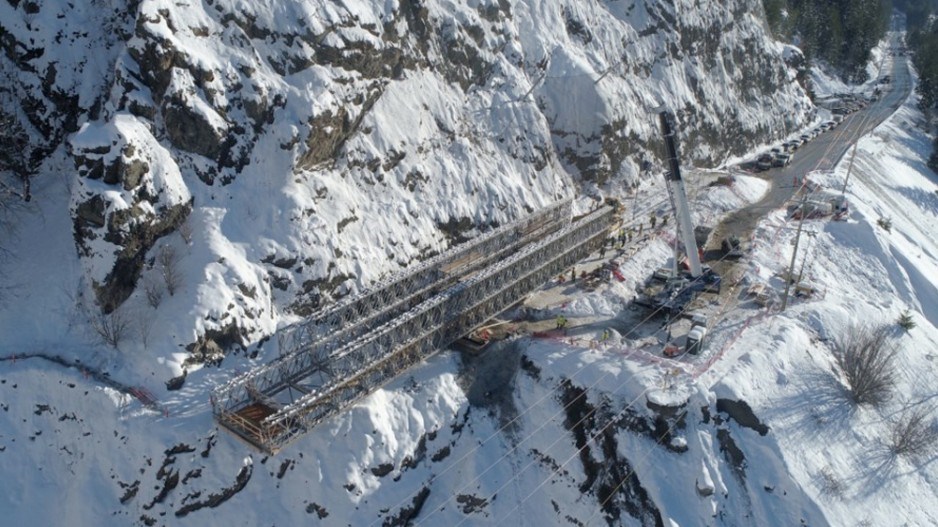As B.C. recovers from last November’s catastrophic floods and mudslides, the province’s construction industry is playing a vital part in the rebuilding effort.
BC Construction Association (BCCA) President Chris Atchison said the association has been working closely with other stakeholders and, along with the Association of Consulting Engineering Companies, has met with Ministry of Transportation and Infrastructure officials to ensure a co-ordinated response and recovery.
“We’ve connected with Emergency Management BC to see how the construction industry can be more directly tapped into emergency response measures and continue to work across government and industry,” Atchison said.
B.C.’s construction industry is “essential” during crisis situations as it works on the front lines of response and recovery, with various contractors needed to help assess damage, clean up, make emergency repairs and provide equipment and supplies, he said.
“The most important thing is that we have an organized, multi-sector, well-planned response and that we are thinking long term about what and how we’re building,” he said.
Road to recovery
Reconnecting affected communities by road, and B.C. to the rest of Canada, was the first crucial step to allow people to move out of afflicted areas and for emergency responders to step in.
Kelly Scott, president of the BC Road Builders and Heavy Construction Association, said members have been assisting provincial and local governments in safely reopening major transportation routes.
“We’ve got an intimate knowledge of these highways, and when this major flood and slide happened, we were there at ground zero working shoulder-to-shoulder with the Ministry of Transportation in assessing what the damage was and helping to determine best practices,” Scott said. “The main concern was trying to get the commercial truck traffic into the Port of Vancouver, which was essential, as well as the rail lines.”
While the Coquihalla Highway reopened in time for the holiday season, damaged sections will need to be rebuilt with climate change in mind, according to Scott. Best practices to mitigate damage from floods and mudslides around the world are being considered.
“Every road in British Columbia needs to be reassessed now due to climate change,” he said.
Co-ordinated approach needed
Rebuilding hard-hit communities means making structures more resilient to future storms, using carbon-neutral materials, having deeper foundations and keeping electrical wiring above flood level, Atchison said.
“We need to do it in a way that creates a recovery code standard rather than a failsafe,” he said. “Our entire approach needs to evolve.”
With supply chains already challenged by COVID-19, the construction industry will likely continue to experience issues due to highway closures, he said.
“It doesn’t seem that the supply problems will go away any time soon. These issues make it very difficult to predict costs and construction schedules, and they really need a co-ordinated government response.”
With the storm’s economic impact estimated at billions of dollars, Atchison said at least $1 billion worth of building materials will be needed.
When it comes to work, “all hands on deck” are needed to rebuild B.C. in new ways to help the province prepare for future natural disasters, according to Atchison. This includes engineers, architects, designers, scientists working with policy makers – with the construction industry at the forefront to ensure constructability and supply chains are considered from the beginning.
“All trades will play a role in rebuilding, from carpenters and electricians, to roofers, painters and landscapers,” he said. “All stakeholders need to work together more proactively in order to rebuild smarter and prepare for the next extreme event.”
The flood added to the industry’s labour shortages, but also created opportunities for workers displaced by the pandemic who may be considering a construction career. Atchison estimates that 26,000 jobs will soon become available due to retirements and industry expansion.
Pitching in
Many construction companies, employees and contractors have been providing financial support for people affected by the extreme weather events. BC Road Builders raised nearly $1.6 million through its Canadian Red Cross flood relief campaign. Members donated about $528,000, which was matched by provincial and federal governments. Funds raised go towards the Canadian Red Cross’s B.C. Floods and Extreme Weather Appeal. The highest amounts raised were $120,000 from heavy equipment deal Brandt, $100,000 from Parkland Corp. (TSX:PKI), and $75,000 from Finning (TSX:FTT). The BCCA, along with other organizations and members, also donated to the campaign.
“I think we all understand the need and the value of coming together collaboratively to contribute to something like this,” said Scott.
Besides raising funds for emergency support to flooded communities, Ledcor also provided two helicopters for government-led relief efforts, and its marine operations helped transport essential supplies to Chilliwack.
Kim Barbero, CEO of the Mechanical Contractors Association of BC, said member employees have been volunteering their time and donating equipment to lend support. During the response phase, mechanical contractors in B.C. and across Canada – as far away as Newfoundland and Labrador – raised more than $105,000 for the Red Cross’s flood relief effort.
Help may also be needed for construction businesses that were directly affected, and the cost and coverage of insurance should be re-examined, according to Atchison.
“Premiums are likely to rise: that’s another hit to small businesses. Our construction industry is 90% small business. About 5% of B.C. is already ineligible for flood insurance. The situation isn’t sustainable.” •




